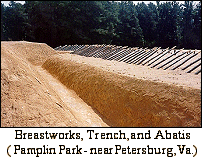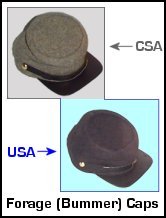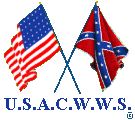
|
U. S. A. CIVIL WAR
|

|
DEFINITIONS
(OF WORDS BEGINNING WITH)
LETTERS
A
THRU
D
PAGE 1 OF 3
SELECT THE FIRST LETTER OF A TERM
A
B
C
D
E
F
G
H
I
J
K
L
M
N
O
P
Q
R
S
T
U
V
W
X
Y
Z
|
OR
SELECT A SPECIFIC TERM
(* = most recent term additions or changes)
|
A
Abatis - Cut trees, sharpened at one end and facing
towards the enemy.
Chevaux-de-frise is similar but
constructed of rough or dressed lumber. (See abatis photograph at breastwork.)
Abolitionist - Person opposed to slavery and in favor
of ending it
Accoutrements - Items of equipment, other than clothing
and weapons, issued to military personnel.
Acoustic Shadow - Atmospheric conditions that form a pocket
of silence around an area. During the Civil War, on some occasions, observers
of a nearby battle reported hearing no battle sounds, while the battle could
be heard clearly by people many miles away.
Adjutant - A staff officer in either the Confederate or
Union army. Communication of orders was one of his main responsibilities. An
adjutant normally issued orders in the name of his commander.
Aeronaut - A person who operates or rides in a balloon.
Affair - On the scale of combat intensity, a minor
military combat encounter of less intensity than a skirmish.
Aide-de-camp - Normally a civilian or foreign observer,
appointed by a general officer. His responsibilities could range from running
errands, up to and including being authorized to modify the general officer's
orders if the officer was absent. Usually the aide had some expertise in
military tactics, and operations.
Aim - To point. "Aim" and "Point" are interchangeable.
Ambulance - A two or four wheeled horse-drawn carriage used to
carry the wounded.
Army - The largest organization body in the Union and
Confederate forces. As with battle names, most of the Union armies were named
after rivers and the Confederate armies were named after states or regions. An
army consisted of one or more corps. The number of corps per army varied
considerably. An army could have only one corps or have seven or eight. Armies
were normally commanded by major generals in the North and full generals in the
South.
Army of the Cumberland - A Western army under the command of
Generals William T. Sherman, William S. Rosecrans, and, mostly, George H. Thomas.
Army of Northern Virginia - Principle Confederate force
in the Easterm Theater of operations. Robert E. Lee was its commander.
Army of the Ohio - A Western army under the command of
U.S.A Maj. Gen. Don Carlos Buell
Army of the Potomac - Principle Federal force in
the Eastern Theater of operations. It had numerous commanders including
McClellan, Burnside, Hooker, and Meade.
Army of Tennessee (Not to be confused with the Federal
"Army of the Tennessee). - After Gen. Braxton Bragg's defeat at
Perryville, Kentucky, October 8, 1862, he and his Confederate Army of the
Mississippi retreated, reorganized, and were redesignated as the Army of
Tennessee.
Army of the Tennessee(The Confederate army was
"Army of Tennessee"...without the "the").- Principle Federal force in
the Western Theater of operations.
Army of Trans-Mississippi - Principle Confederate force
in the Western Theater of operations.
Army of Vicksburg - Confederate force, under Lt. Gen.
John C. Pemberton, which defended and surrendered Vicksburg.
Army of Virginia - A Federal force formed in 1862, under
the command of Major General John Pope, which fought the Confederates at the
battles of Cedar Mountain and Second Manassas while the Army of the Potomac
returned from its failed peninsula campaign near Richmond.
Artillery - Cannon and mortars used in the Civil War to
support the infantry and defend fixed positions.
RETURN TO
TOP OF PAGE
B
Barbette - A raised wooden platform, usually in permanent
fortifications, that allowed an
artillery piece to be fired over a wall without
exposing its gun crew.
Barrage - Continuous firing of
artillery involving many cannon.
Battalion - (1) A command made up of two or more
companies detached for special duty, such as
sharpshooters. (2) Companies of infantry serving apart from the main body,
and usually included a Headquarters company and
artillery.
Battery - A term applied to one or more pieces of
artillery. In the Union army a battery was made up of six cannon. In the
Confederate army a battery was made up of four cannon. Batteries were normally
under the command of a captain.
Battle above the Clouds - Referring to the battle for
cloud-covered Lookout Mountain, Tennessee on November 24, 1864.
Bayonet - A removable knife which could be attached to
the front of a musket or rifle. It was designed to make the musket or rifle a
deadly weapon in hand-to-hand combat.
Bedroll - Rolled blankets carried by soldiers which also
contained their personal belongings.
Billow - to surge; to rise or roll in like billows; to swell
out, puff up, etc., as by the action of wind: flags billowing in the breeze.
Bivouac (also, camp) - A temporary
encampment or shelter for a military unit.
Black Powder - An explosive consisting of a compound of
potassium nitrate, sulfur and charcoal.
Blockade - The blocking of waterways, or inlets, by
ships of war.
Bold Dragoon - Referring to Confederate General J. E. B. "Jeb"
Stuart.
(See Dragoon.)
Bondage - Slavery; a state of being bound by law.
Border States - Delaware, Kentucky, Maryland, and
Missouri were considered border states. They were located on the border between
the U.S.A. and C.S.A. and had questionable loyalty to either side.
Bough - An unusually large or main branch of a tree.
Bounty - A sum of money paid to entice enlistment in the
military. The armies of both the North and the South paid
bounties of several hundred dollars per enlistee. Bounty
is also used to indicate money offered to catch a criminal or deserter.
Bower - A shelter of boughs or
vines.
Breach - An opening or rupture made in the wall of a
fortification.
 Breastwork - An entrenchment, or field trench, made of
earth and wood, designed to protect the defenders against enemy fire. When
possible, the front of the work was protected by a deep ditch or other
obstructions such as an abatis or
Chevaux-de-frise.
Breastwork - An entrenchment, or field trench, made of
earth and wood, designed to protect the defenders against enemy fire. When
possible, the front of the work was protected by a deep ditch or other
obstructions such as an abatis or
Chevaux-de-frise.
Brevet Rank - A commission giving a military officer
higher nominal rank than that for which pay is received
Brigade - With three to six regiments (500-1,000 men per
regiment), a brigade was normally led by a brigadier general. The Confederate
brigade usually consisted of more regiments than the Union brigade.
Buck and Ball - A musket load having 3 buckshot bound on
top of a .69 caliber, smooth bore musket ball, encased in paper. It was not
used much during the war because of its inaccuracy at a distance.
Buck and Gag (Bucking) - A form of corporal punishment
which had the offending soldier placed on the ground with his hands and feet
bound. His knees were drawn up between his arms and a rod was inserted under his
knees and over his arms. It was used for a variety of offenses.

Bummers - (1)
Foraging or marauding soldiers in the Civil War. Union Bummers were
especially prevalent during Sherman's march to the sea. (2) A person
who was safely to the rear of the army or otherwise away from combat. (3) A
forage or fatigue cap.
Butternut - One of the uniforms commonly used by the
Confederate soldier was colored by a dye made with, among other things, walnut
hulls. It had a yellow-brown color and was called butternut. Because of the
uniform color, the Confederate soldiers were frequently called Butternuts.
RETURN TO
TOP OF PAGE
C
Caisson - An ammunition wagon for artillery.
Caliber - The diameter of the bore of a gun; the
diameter of a bullet or shell.
Camouflet - An explosive placed in front of an
enemy mine by a
counter mine. It would explode when struck by a pick or shovel. The
Confederates tried this at Vicksburg
Camp - (also, bivouac) A temporary
encampment or shelter for a military unit.
Campaign - connected series of military operations
forming a phase of a war.
Canister - A type of Civil War artillery ammunition, similar to
grapeshot but with more balls of a
smaller size. Canister resembled a coffee can containing layers of metal balls
packed in sawdust. It was highly effective at close range against
attacking troops.
Cap - A small device designed to explode powder in a
musket.
Cap Box - A leather box, attached to a soldier's belt,
holding caps used to fire muskets.
Carpetbagger - A derogatory Southern term used to
identify a corrupt Northerner who came South after the war in order to use the
political process for self-enrichment.
Carronade - A short cannon, designed to throw a large projectile
with small velocity for the purpose of breaking or smashing rather than piercing,
was invented by the British General Robert Melville and received its name from
being cast by the Carron Foundry in Scotland.
Destructive at close quarters, the Carronade fired a 32 pound shot with 2 pounds
10 ounces of powder. At one degree of elevation, it would carry for 380 yards.
Originally designed as a lightweight, low velocity piece of artillery that could
keep up with the infantry rather than the heavier, bulkier 18th century cannons
that were difficult to transport, it was later adapted for naval gunfire.
Although 4-9 men were used to man the Carronade, with its relatively light weight,
as few as two men could man this gun. The Carronade measured 4 feet to 4 feet 10
inches long, with a 6.5 inch bore and weighed about 2,000 pounds.
It was used in the 18th and 19th centuries as a powerful, short-range anti-ship
and anti-crew weapon. While considered very successful early-on, Carronades
eventually disappeared as long-range naval artillery led to fewer and fewer
close-range engagements.
Carte de viste (CDV) - A 2 1/4 by 3 3/4 inch photographic card.
Cartridge - A tube, mainly paper, holding a bullet and
gun powder.
Cartridge Box - A leather box holding cartridges.
Cascabel - The Knob at the breech end of a cannon.
Case Shot - Similar to a regular cannon shell but with
thinner walls. Inside the shell, in the center of the cavity, black powder was
placed in a thin tin or iron container. The cavity around the container was
filled with lead or iron balls and sulphur. The shell was designed to fire the
balls in a cone-shaped pattern when the black powder exploded. Similar to
canister, case shot was designed to give the same effect as canister but at a
longer range.
Casualty - Military person lost through death, wounds,
injury, sickness, capture, or missing in action
Cavalry - Men, trained and equipped, who fight from
horseback. Not the same as mounted infantry.
Celerity - swiftness, speed.
Chain Shot - Artillery
ammunition initially designed to attack sailing vessels. It consisted of two
hemispheres of a hollow cannon ball connected by a short length of chain. The
two hemispheres were closed together, with the chain inside, for loading. When
shot, the hemispheres broke apart but continued to be held by the chain. This
deadly, whirling, missile was effective only at a close range, beyond which
the accuracy of the shot declined precipitously.
Chevaux-de-frise - Sharp poles arranged to obstruct
attacking infantry or cavalry. The poles were placed in holes that were drilled,
at regular intervals, in a log about ten feet long and a foot thick. The poles,
about two or three feet long, protruded from the log at a right angle. The
chevaux-de-frize was used to block gaps or breaches in a line, and to obstruct
the enemy's approach to forts or breastworks. See also
Abatis
Cold Steel - bayonet.
Color Bearer - a person carrying a flag especially during combat.
Columbiad - A term applied to most large, smoothbore
costal artillery pieces in the pre-Civil War period. One type is known as the
Rodman, after its designer.
Commutation - The substitution of one form of payment or
penalty for another. During the Civil War "commutation" meant legally evading
the draft by paying a "commutation fee". This fee, usually several hundred
dollars, was paid by approximately 87,000 draftees during the war.
Company - A company consisted of 50 to 100 men commanded
by a captain. With enough men, a company was usually divided into 2 platoons.
Each platoon was then divided into two sections and, finally, each section
contained 4 squads.
Thus, ideally, a company would equal two platoons, which would equal four
sections, which would equal eight squads. Sergeants normally ran the sections,
and corporals led the squads.
Ten companies normally made up a regiment.
Conscription - The Civil War name for what is now known
as the draft. Those persons "conscripted" were call "Conscripts". Both sides used
Conscription. Conscription was so disliked in the north that there were draft
riots in New York.
Contraband - A term was used to described fugitive
slaves who sought protection behind Union lines during the Southern invasion.
It was first used by Union general Benjamin F. Butler when he learned that
fugitives were working for the Confederacy war effort.
Copperheads - Starting in 1861, Republicans called antiwar
Democrats "copperheads", comparing them to the poisonous snake.
Copse - A thicket, grove, or growth of small trees.
corps - A Corps was composed of two or more divisions
led by a lieutenant general (Confederacy) or a major general (Union).
Corps de Chasseurs - A body of troops trained and
equipped for rapid movement.
Cottonclad - a ship with bales of cotton placed on
the deck to provide some protection from enemy fire.
Counterattack - An attack made to counter
(off-set) an attack by the enemy.
Counter Mine - A tunnel for intercepting an enemy mine.
Coup de main - A fast attack that surprises the enemy.
Cross Fire - Firing from two or more points so that the
lines of fire cross.
RETURN TO
TOP OF PAGE
D
Debouches - Openings in a fortification where troops
may enter or leave.
Defilading Battery - A battery placed on a raised
parapet for protection from artillery on a commanding height.
Deo Vindice - "God Favor Our Cause" The motto on the
Great Seal of the Confederacy.
Deploy - To move units to a desired position on the battlefield.
Destruction in Detail - The destruction of an
opposing force one small part at a time.
Dismounted Cavalry - Cavalry, dismounted from their
horses, being used temporarily as infantry for ground fighting. Generally, a
cavalryman did not have the same weapons as an infantryman.
Division - Usually containing three or four brigades
(North) or four to six brigades (South), a division was commanded by a major
general. A Southern division tended to be twice as large as its Northern
counterpart.
Dragoon - From the French (1604), dragon, dragon, dragoon. A
member of a European military unit composed of heavily armed mounted
troops. Confederate General J.E.B. Stuart was called the
Bold Dragoon.
RETURN TO
TOP OF PAGE
|
PAGE TWO
(
 OR
Photograph Page
)
>
Definitions
>
Page 2
>
Page 3
OR
Photograph Page
)
>
Definitions
>
Page 2
>
Page 3
|
|



